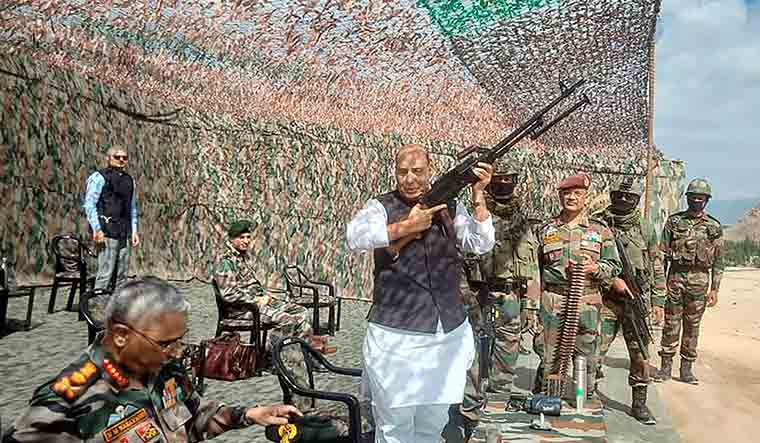The Chinese government is putting pressure on the families of PLA soldiers, who died in the clash with Indian soldiers in the Galwan Valley, not to conduct burials and in-person funeral ceremonies. The move is part of an attempt to cover up an episode that Beijing views as a blunder, according to a report in the American online news portal US News and World Report.
The news portal, which claims that the news is based on a US intelligence assessment, states that the Chinese ministry of civil affairs has told families of the soldiers that they must forego traditional burial ceremonies and cremate the remains of the soldiers, and that any funeral ceremonies should be conducted remotely, not in person. These instructions are part of a deliberate effort by Beijing to erase any reminders of the clash.
Despite that, concern among Chinese citizens is growing. There are reports on Chinese social media such as Weibo that people are sharing pictures of funeral processions for Indian troops, and wondering why their countrymen didn’t receive similar honours. Chinese authorities have not released any information identifying the names and ranks of the PLA soldiers who died in the clash.
According to the US assessment, the Chinese government considers the casualties among their troops as a national humiliation for its armed forces and thus decided not reveal the details of soldiers killed in action for the fear of emboldening other adversaries.
The clash took place in the Galwan Valley when a senior Indian Army officer, Colonel Suresh Babu, and two of his soldiers, were brutally attacked by Chinese soldiers using clubs studded with barbed wire, and iron rods. The Indian soldiers had gone unarmed to meet their Chinese counterparts, to discuss de-escalation measures agreed upon between Indian and Chinese military commanders on June 6. The attack was premeditated, not accidental.
Twenty Indian soldiers, including Colonel Babu, were killed in the hand-to-hand combat that took place, sparking widespread outrage in India. Though the Chinese government has officially not released the number of dead on its side, US intelligence estimates that 35 Chinese soldiers, including one senior officer, died in the clash. The Times of India, on the other hand, has reported 43 Chinese casualties in the brawl.
The killing of the 20 Indian soldiers—the first in 45 years—has inflamed Indian public opinion, and caused intense anger among Indian policymakers and the country’s elite. Anti-China demonstrations have broken-out in many cities, calling for a boycott of Chinese goods, including mobile phones and clothes. “This time, more than India’s bullet power, wallet power will be useful,” says Sonam Wangchuk, who works in the field of education reform in Ladakh.
Wangchuk conveyed his message in a video released on May 28, which already has more than 4.2 million views. He claims that the money Indians spend on Chinese products is indirectly funding their military and ultimately killing Indian soldiers. Celebrities and Indian citizens are heeding Wangchuk’s call. Hashtags such as #BoycottChina and #BoycottChineseProducts have been circulating widely on Indian social media platforms, including LinkedIn. A video that shows a man throwing his flat-screen TV, presumably made in China, from the first floor of an apartment building, was viewed 2.4 million times.
The Indian government has also reacted, though in a measured way. On June 29, it banned the use of 59 mobile apps from China, including TikTok and UC Browser, which have millions of users in India. Earlier, on June 23, Indian authorities issued a rule that sellers on the country’s e-marketplace must have the 'country of origin' tag on all products. It is likely to adversely affect imports from China, which touched an all-time high of $95 billion in 2018.
The government has also cancelled several infrastructure projects in which Chinese companies had won the contract. The Chinese company Huawei, which has been trying hard to win the contract for launching 5G services in India, is now very unlikely to do so, particularly after Reliance Jio announced on July 15 that it would roll out an indigenous 5G network in India next year. Self-sufficiency in strategic sectors such as pharmaceuticals, power and telecom is being encouraged by the government.
Geopolitically, the outcome has been equally, if not more, disastrous for China, which has always viewed India’s growing relations with the US with suspicion. The killing of Indian soldiers has brought India and the US closer. China has also been wary of what has come to be known as the “Quad,” comprising the US, India, Japan and Australia. These countries look with disfavour upon China’s activities in the South China Sea and the Indo-Pacific. Again, the members of the Quad have come closer as a result of the Chinese action.
Above all, India has now openly declared that the era of “expansionism” is over. That was done by Prime Minister Narendra Modi when he addressed Indian troops in Ladakh on July 3. It was reinforced by the message conveyed by India’s Defence Minister Rajnath Singh, during his visit to a forward post of the Indian Army near the Pangong Lake on July 17.
Singh said he hoped talks between the two countries “should resolve the matter,” but that he did not know “to what extent it will be resolved.” He told the Indian troops that he wanted to “assure you that no power in the world can touch an inch of Indian territory or capture it.” He said India wants peace, but is capable of a befitting reply if anyone tries to hurt its self-respect. Singh also witnessed assault drills by Special Forces of the Indian Army and the Indian Air Force. That would not have taken place before the Galwan incident, which marks an inflection point in India’s China policy.
(Niraj Srivastava is a former Ambassador of India. The opinions expressed in this article are those of the author's and do not purport to reflect the opinions or views of THE WEEK)



